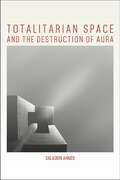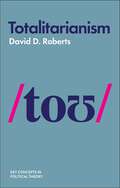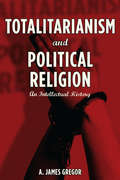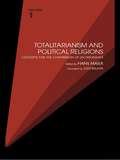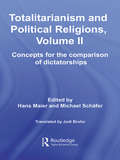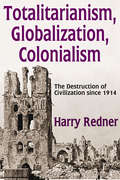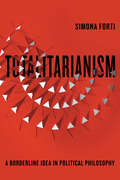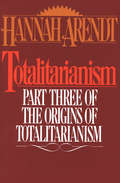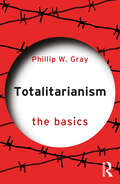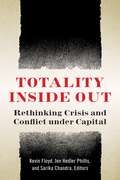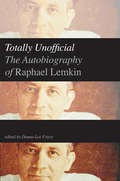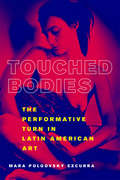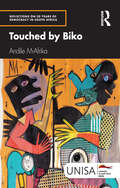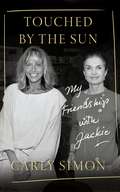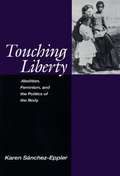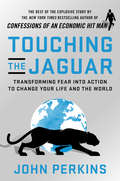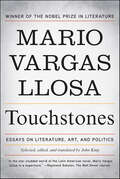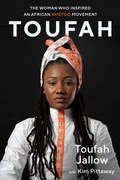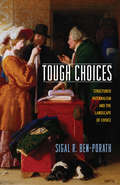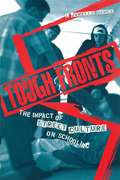- Table View
- List View
Totalitarian Space and the Destruction of Aura
by Saladdin AhmedWe live today within a system in which state and corporate power aim to render space flat, transparent, and uniform, for only then can it be truly controlled. The gaze of power and the commodity form are capable of infiltrating even the darkest of corners, and often, we invite them into our most private spaces. We do so as a matter of convenience, but also to placate ourselves and cope with the alienation inherent in our everyday lives. The resulting dominant space can best be termed totalitarian. It is space stripped of uniqueness, deprived of the "spatial aura" necessary for authentic experience. In Totalitarian Space and the Destruction of Aura, Saladdin Ahmed sets out to help us grasp what has been lost before no trace remains. He draws attention to that which we might prefer not to see, but despite the bleakness of this indictment of reality, the book also offers a message of hope. Namely, it is only once we comprehend the magnitude of the threat to our spatial experience and our own complicity in sustaining this system that we can begin to resist the totalizing forces at work.
Totalitarianism (Key Concepts in Political Theory)
by David D. RobertsLess than a century old, the concept of totalitarianism is one of the most controversial in political theory, with some proposing to abandon it altogether. In this accessible, wide-ranging introduction, David Roberts addresses the grounds for skepticism and shows that appropriately recast—as an aspiration and direction, rather than a system of domination—totalitarianism is essential for understanding the modern political universe. Surveying the career of the concept from the 1920s to today, Roberts shows how it might better be applied to the three ""classic"" regimes of Fascist Italy, Nazi Germany, and the Stalinist Soviet Union. Extending totalitarianism’s reach into the twenty-first century, he then examines how Communist China, Vladimir Putin's Russia, the Islamic Republic of Iran, the self-proclaimed Islamic State (IS), and the threat of the technological “surveillance state” can be conceptualized in the totalitarian tradition. Roberts shows that although the term has come to have overwhelmingly negative connotations, some have enthusiastically pursued a totalitarian direction—and not simply for power, control, or domination. This volume will be essential reading for any student, scholar or reader interested in how totalitarianism does, and could, shape our modern political world.
Totalitarianism and Political Religion: An Intellectual History
by Gregor A. JamesThe totalitarian systems that arose in the twentieth century presented themselves as secular. Yet, as A. James Gregor argues in this book, they themselves functioned as religions. He presents an intellectual history of the rise of these political religions, tracing a set of ideas that include belief that a certain text contains impeccable truths; notions of infallible, charismatic leadership; and the promise of human redemption through strict obedience, selfless sacrifice, total dedication, and unremitting labor. Gregor provides unique insight into the variants of Marxism, Fascism, and National Socialism that dominated our immediate past. He explores the seeds of totalitarianism as secular faith in the nineteenth-century ideologies of Ludwig Feuerbach, Moses Hess, Karl Marx, Friedrich Engels, Giuseppe Mazzini, and Richard Wagner. He follows the growth of those seeds as the twentieth century became host to Leninism and Stalinism, Italian Fascism, and German National Socialism-each a totalitarian institution and a political religion.
Totalitarianism and Political Religions Volume III: Concepts for the Comparison Of Dictatorships - Theory & History of Interpretations (Totalitarianism Movements and Political Religions)
by Hans MaierAvailable for the first time in English language translation, the third volume of Totalitarianism and Political Religions completes the set. It provides a comprehensive overview of key theories and theorists of totalitarianism and of political religions, from Hannah Arendt and Raymond Aron to Leo Strauss and Simone Weill. Edited by the eminent Professor Hans Maier, it represents a major study, examining how new models for understanding political history arose from the experience of modern despotic regimes. Where volumes one and two were concerned with questioning the common elements between twentieth century despotic regimes - Communism, Fascism, National Socialism, Maoism – this volume draws a general balance. It brings together the findings of research undertaken during the decade 1992-2002 with the cooperation of leading philosophers, historians and social scientists for the Institute of Philosophy at the University of Munich. Following the demise of Italian Fascism (1943-45), German National Socialism (1945) and Soviet Communism (1989-91), a comparative approach to the three regimes is possible. A broad field of interpretation of the entire phenomenon of totalitarian and political religions opens up. This comprehensive study examines a vast topic which affects the political and historical landscape over the whole of the last century. Moreover, dictatorships and their motivations are still present in current affairs, today in the twenty-first century. The three volumes of Totalitarianism and Political Religions are a vital resource for scholars of fascism, Nazism, communism, totalitarianism, comparative politics and political theory.
Totalitarianism and Political Religions, Volume 1: Concepts for the Comparison of Dictatorships (Totalitarianism Movements and Political Religions #Vol. 1)
by Hans MaierWe are used to distinguishing the despotic regimes of the 20th century - communism, fascism, National Socialism, Maoism - very precisely according to place and time, origins and influences. But what should we call that which they have in common? On this question, there has been and is still a passionate debate.This book documents the first international conference on this theme, a conference that took place in September of 1994 at the University of Munich. The book shows how new models for understanding political history arose from the experience of modern despotic regimes. Here, the most important concepts - totalitarianism and political religions - are discussed and tested in terms of their usefulness.
Totalitarianism and Political Religions, Volume II: Concepts for the Comparison Of Dictatorships (Totalitarianism Movements and Political Religions)
by Michael Schäfer Hans MaierAvailable for the first time in English language translation, this is the long-awaited second volume of the three part set on Totalitarianism and Political Religions, edited by the eminent Professor Hans Maier. This represents a major study, with contributions from leading scholars of political extremism, sociology and modern history, the book shows how new models for understanding political history arose from the experience of modern despotic regimes. We are used to distinguishing the despotic regimes of the twentieth century - Communism, Fascism, National Socialism, Maoism - very precisely according to place and time, origins and influences. But what should we call that which they have in common? On this question, there has been, and still is, a passionate debate. Indeed, the question seemed for a long time not even to be admissible. Clearly this state of affairs is unsatisfactory. The debate has been renewed in the past few years. After the collapse of the communist systems in Central, East and Southern Europe, a (scarcely surveyable) mass of archival material has become available. Following the lead of Fascism and National Socialism, communist and socialist regimes throughout the world now belong to the historical past as well. This leads to the resumption of old questions: what place do modern despotisms assume in the history of the twentieth century? What is their relation to one another? Should they be captured using traditional concepts – autocracy, tyranny, despotism, dictatorship – or are new concepts required? Here, the most important concepts - totalitarianism and political religions - are discussed and tested in terms of their usefulness. This set of volumes is as topical and relevant to current world events in the twenty first century.
Totalitarianism, Globalization, Colonialism: The Destruction of Civilization Since 1914
by Harry RednerThe century that began in 1914 with the outbreak of the First World War was catastrophic. Over the course of that one-hundred-year span, civilizations were destroyed in the Old World, the New World, and the Third World, the latter represented by China, India, and Islam.In Europe the main agent of destruction was totalitarianism; in America it was globalization, ushered in by modernity; and in the non-Western world it was colonialism, followed later by totalitarianism and globalization. Harry Redner examines each of these processes, providing theoretical and historical accounts of their emergence. He considers the effects of Nazism and Bolshevism on the morale and morals of Europe; studies the effects on the United States of the nation's emergence as a major world power; and describes the impact of modernization on China, India, and Islam as they underwent Europeanization, Sovietization, and Americanization.Redner confronts us with a paradox: in the midst of unprecedented material affluence and organizational efficiency, one that uses advanced technologies and cutting-edge scientific knowledge, we are also sinking into an unprecedented cultural, moral, intellectual, and spiritual decline. He locates the origins of this condition in the violently contradictory processes of the twentieth century.
Totalitarianism: A Borderline Idea in Political Philosophy (Square One: First-Order Questions in the Humanities)
by Simona FortiIn the last decade, we have witnessed the return of one of the most controversial terms in the political lexicon: totalitarianism. What are we talking about when we define a totalitarian political and social situation? When did we start using the word as both adjective and noun? And, what totalitarian ghosts haunt the present? Philosopher Simona Forti seeks to answer these questions by reconstructing not only the genealogy of the concept, but also by clarifying its motives, misunderstandings, and the controversies that have animated its current resurgence. Taking into account political theories and historical discussions, Totalitarianism especially focuses on philosophical reflections, from the question of totalitarian biopolitics to the alleged totalitarian drifts of neoliberalism. The work invites the relentless formulation of a radical question about the democratic age: the possibilities it has opened up, the voids it leaves behind, the mechanisms it activates, and the "voluntary servitude" it produces. Forti argues that totalitarianism cannot be considered an external threat to democracy, but rather as one of the possible answers to those questions posed by modernity which democracies have not been able to solve. Her investigation of the uses and abuses of totalitarianism as one of the fundamental categories of the twentieth and twenty-first centuries promises to provoke much-needed discussion and debate among those in philosophy, politics, ethics, and beyond.
Totalitarianism: Part Three of The Origins of Totalitarianism (Origins Of Totalitarianism Ser.)
by Hannah ArendtThe great twentieth-century political philosopher examines how Hitler and Stalin gained and maintained power, and the nature of totalitarian states. In the final volume of her classic work The Origins of Totalitarianism, Hannah Arendt focuses on the two genuine forms of the totalitarian state in modern history: the dictatorships of Bolshevism after 1930 and of National Socialism after 1938. Identifying terror as the very essence of this form of government, she discusses the transformation of classes into masses and the use of propaganda in dealing with the nontotalitarian world—and in her brilliant concluding chapter, she analyzes the nature of isolation and loneliness as preconditions for total domination. &“The most original and profound—therefore the most valuable—political theoretician of our times.&” —Dwight Macdonald, The New Leader
Totalitarianism: The Basics (The Basics)
by Phillip W. GrayTotalitarianism: The Basics is an easy-to-read introduction into the main concepts, ideologies, and regimes associated with totalitarianism. Starting with an overview of how scholars have attempted to define totalitarianism, Phillip W. Gray begins with an examination of the various types of terms used, helping the reader think about how these terms do – and do not – apply to different ideologies and governments. Easily accessible language and the use of numerous examples aid readers in seeing the connections between certain types of ideologies and some forms of organization/movements in their relation to historically well-known totalitarian regimes. Gray concludes with the tools necessary to think through how to distinguish between an actual (or potential) totalitarian system and regimes that, while oppressive or authoritarian, would not be totalitarian in nature. A rich bibliography containing additional readings bookend the text. Totalitarianism: The Basics offers an essential introduction for students from all backgrounds seeking to understand totalitarianism and for general readers with an interest in political ideologies and extremism. For those knowledgeable in this field, it adds conceptual relevance and a variety of ways of thinking about the term.
Totality Inside Out: Rethinking Crisis and Conflict under Capital
by Kevin Floyd, Jen Hedler Phillis, and Sarika ChandraHowever divergent their analyses may be in other ways, some prominent anti-capitalist critics have remained critical of contemporary debates over reparative justice for groups historically oppressed and marginalized on the basis of race, gender, sexual identity, sexual preference, and/or ability, arguing that the most these struggles can hope to produce is a more diversity-friendly capital. Meanwhile, scholars of gender and sexuality as well as race and ethnic studies maintain that, by elevating the socioeconomic above other logics of domination, anti-capitalist thought fails to acknowledge specific forms and experiences of subjugation.The thinkers and activists who appear in Totality Inside Out reject this divisive logic altogether. Instead, they aim for a more expansive analysis of our contemporary moment to uncover connected sites of political struggle over racial and economic justice, materialist feminist and queer critique, climate change, and aesthetic value. The re-imagined account of capitalist totality that appears in this volume illuminates the material interlinkages between discrepant social phenomena, forms of oppression, and group histories, offering multiple entry points for readers who are interested in exploring how capitalism shapes integral relations within the social whole.Contributors: Brent Ryan Bellamy, Sarah Brouillette, Sarika Chandra, Chris Chen,Joshua Clover, Tim Kreiner, Arthur Scarritt, Zoe Sutherland, Marina Vishmidt
Totally Unofficial
by Donna-Lee Frieze Raphael LemkinAmong the greatest intellectual heroes of modern times, Raphael Lemkin lived an extraordinary life of struggle and hardship, yet altered international law and redefined the world's understanding of group rights. He invented the concept and word "genocide" and propelled the idea into international legal status. An uncommonly creative pioneer in ethical thought, he twice was nominated for the Nobel Peace Prize.Although Lemkin died alone and in poverty, he left behind a model for a life of activism, a legacy of major contributions to international law, and--not least--an unpublished autobiography. Presented here for the first time is his own account of his life, from his boyhood on a small farm in Poland with his Jewish parents, to his perilous escape from Nazi Europe, through his arrival in the United States and rise to influence as an academic, thinker, and revered lawyer of international criminal law.
Touched Bodies: The Performative Turn in Latin American Art
by Mara Polgovsky EzcurraWhat is the role of pleasure and pain in the politics of art? In Touched Bodies, Mara Polgovsky Ezcurra approaches this question as she examines the flourishing of live and intermedial performance in Latin America during times of authoritarianism and its significance during transitions to democracy. Based on original documents and innovative readings, her book brings politics and ethics to the discussion of artistic developments during the “long 1980s”. She describes the rise of performance art in the context of feminism, HIV-activism, and human right movements, taking a close look at the work of Diamela Eltit and Raúl Zurita from Chile, León Ferrari and Liliana Maresca from Argentina, and Marcos Kurtycz, the No Grupo art collective, and Proceso Pentágono from Mexico. The comparative study of the work of these artists attests to a performative turn in Latin American art during the 1980s that, like photography and film before, recast the artistic field as a whole, changing the ways in which we perceive art and understand its role in society.
Touched by Biko (30 Years of Democracy in South Africa)
by Andile M-AfrikaIn Touched by Biko, Andile M-Afrika writes about his memories of Ginsberg, the black township across the Buffalo River from central King William’s Town which was also home to Steve Bantu Biko. The book has been developed from his MA Creative Writing thesis, which he completed at Rhodes University in 2013.Print editions not for sale in Sub-Saharan Africa. This book is part of Routledge’s co-published series 30 Years of Democracy in South Africa, in collaboration with UNISA Press, which reflects on the past years of a democratic South Africa and assesses the future opportunities and challenges.
Touched by the Sun: My Friendship with Jackie
by Carly SimonA chance encounter at a summer party on Martha's Vineyard blossomed into an improbable but enduring friendship. Carly Simon and Jacqueline Kennedy Onassis made an unlikely pair - Carly, a free and artistic spirit still reeling from her recent divorce, searching for meaning, new love, and an anchor; and Jackie, one of the most celebrated, meticulous, unknowable women in American history. Nonetheless, over the next decade their lives merged in inextricable and complex ways, and they forged a connection deeper than either could ever have foreseen. The time they spent together - lingering lunches and creative collaborations, nights out on the town and mundane movie dates - brought a welcome lightness and comfort to their days, but their conversations often veered into more profound territory as they helped each other navigate the shifting waters of life lived, publicly, in the wake of great love and great loss.An intimate, vulnerable, and insightful portrait of the bond that grew between two iconic and starkly different American women, Carly Simon's Touched by the Sun is a chronicle, in loving detail, of the late friendship she and Jackie shared. It is a meditation on the ways someone can unexpectedly enter our lives and change its course, as well as a celebration of kinship in all its many forms.
Touching Liberty: Abolition, Feminism, and the Politics of the Body
by Karen Sánchez-EpplerIn this study of the pre-Civil War literary imagination, Karen Sánchez-Eppler charts how bodily difference came to be recognized as a central problem for both political and literary expression. Her readings of sentimental anti-slavery fiction, slave narratives, and the lyric poetry of Walt Whitman and Emily Dickinson demonstrate how these texts participated in producing a new model of personhood converged with the sexually distinct and domestically circumscribed female body.
Touching the City: Thoughts on Urban Scale (Architectural Design Primer)
by Timothy MakowerScale in cities is relative and absolute. It has the ability to make us feel at home in the world or alien from it; connected or disconnected. Both large and small scale in cities can be beautiful; both are right, neither is wrong. Whilst accepting that prescription is no answer, 'getting the scale right' – at an intuitive and sensual level – is a fundamental part of the magic of architecture and urban design. Touching the City explores how scale is manifested in cities, exploring scale in buildings, in the space between them and in their details. It asks how scale makes a difference. Travelling from Detroit to Chandigarh, via New York, London, Paris, Rome and Doha, Tim Makower explores cities with the analytical eye of a designer and with the experiential eye of the urban dweller. Looking at historic cities, he asks what is good about them: what can we learn from the old to inform the new? The book zooms in from the macro scale of surfing Google Earth to micro moments such as finding fossils in a weathered wall. It examines the dynamics and movement patterns of cities, the making of streets and skylines, the formation of thresholds and facades, and it also touches on the process of design and the importance of drawing. As the book's title, Touching the City, suggests, it also emphasises the tactile – that the city is indeed something physical, something we can touch and be touched by, alive and ever changing.
Touching the Jaguar: Transforming Fear into Action to Change Your Life and the World
by John Perkins"This eloquent book inspires us to create a new reality of what it means to be humans on this magnificent planet."—Deepak ChopraThis all happened while Perkins was a Peace Corps volunteer. Then he became an "economic hit man" (EHM), convincing developing countries to build huge projects that put them perpetually in debt to the World Bank and other US-controlled institutions. Although he'd learned in business school that this was the best model for economic development, he came to understand it as a new form of colonialism. When he later returned to the Amazon, he saw the destructive impact of his work. But a much more profound experience emerged: Perkins was inspired by a previously uncontacted Amazon tribe that "touched its jaguar" by uniting with age-old enemies to defend its territory against invading oil and mining companies. For the first time, Perkins details how shamanism converted him from an EHM to a crusader for transforming a failing Death Economy (exploiting resources that are declining at accelerating rates) into a Life Economy (cleaning up pollution, recycling, and developing green technologies). He discusses the power our perceptions have for molding reality. And he provides a strategy for each of us to change our lives and defend our territory—the earth—against current destructive policies and systems.
Touchstones: Essays on Literature, Art, and Politics
by Mario Vargas LlosaOne of Latin America's most garlanded novelists—and the recipient of the 2010 Nobel Prize in Literature—Mario Vargas Llosa is also an acute and wide-ranging cultural critic and an acerbic political commentator. Touchstones collects Vargas Llosa's brilliant readings of seminal twentieth-century novels, from Heart of Darkness to The Tin Drum; incisive essays on political and social thinkers; and contemporary pieces on 9/11 and the immediate aftermath of the war in Iraq.Fantastically intelligent, inspired, and surprising, Touchstones is a landmark collection of essays from one of the world's leading writers and intellectuals.
Toufah: The Woman Who Inspired an African #MeToo Movement (Eyewitness Memoirs Ser.)
by Toufah Jallow&“This powerful story shouldn&’t be missed.&” Publishers Weekly (starred) &“A fiercely readable, potent memoir of a survivor who refuses to be silenced. . . . An inspirational page-turner." Kirkus Reviews (starred) An incandescent and inspiring memoir from a courageous young woman who, after she was forced to flee to Canada from her home in The Gambia, became the first woman to publicly call the country&’s dictator to account for sexual assault—launching an unprecedented protest movement in West Africa. In 2015, Toufah Jallow was a nineteen-year-old dreaming of a scholarship. Encouraged by her mother, she entered a presidential competition designed to identify and support the country&’s smart young women, ands he won. Which brought her to the attention of Yahya Jammeh, the country&’s dictator, who styled himself as a pious yet progressive protector of women. At first, he behaved in a fatherly fashion towards his winner, butthen he proposed marriage. When Toufah turned him down, he drugged and raped her. She could not tell anyone what happened. Not only was there no word for rape in her native language, if she told her parents, they would take action and incur Jammeh&’s wrath. Wearing a niqab to hide her identity, she gave his security operatives the slip and fled to Senegal, eventually making her way to safety in Canada. Then Jammeh was deposed. In July 2019, Toufah Jallow went home to testify against him in a public hearing, sparking marches of support and a social media outpouring of shared stories among West African women. Each bold decision Toufah made helped secure the future Jammeh had tried to steal from her, and also showed her a new path of leadership and advocacy for survivors of sexual violence.
Toufah: The Woman Who Inspired an African #MeToo Movement (Eyewitness Memoirs)
by Toufah Jallow Kim Pittaway*One of The Most Anticipated Books of Fall 2021 (Kirkus Reviews, Publishers Weekly)* "This powerful story shouldn&’t be missed." —Publishers Weekly (starred review) An incandescent and inspiring memoir of resilience from a courageous young woman whose powerful advocacy brings to mind the presence, resolve, and moral authority of Amanda Gorman and Greta ThunbergBefore launching an unprecedented protest movement, Toufah Jallow was just a 19-year-old dreaming of a scholarship. Encouraged by her mother to pursue her own ambitions, Toufah entered a presidential competition purportedly designed to identify the country's smart young women and support their educational and career goals. Toufah won. Yahya Jammeh, the dictator who had ruled The Gambia all of Toufah's life, styled himself as a pious yet progressive protector of women. At first he behaved in a fatherly fashion toward Toufah, but then proposed marriage, and she turned him down. On a pretext, his female cousin then lured Toufah to the palace, where he drugged and raped her. Toufah could not tell anyone. There was literally no word for rape in her native language. If she told her parents, they would take action, and incur Jammeh's wrath. Wearing a niqab to hide her identity, she gave Jammeh&’s security operatives the slip and fled to Senegal. Her eventual route to safety in Canada is full of close calls and intrigue. 18 months after Jammeh was deposed, Toufah Jallow became the first woman in The Gambia to make a public accusation of rape against him, sparking marches of support and a social media outpouring of shared stories among West African women under #IAmToufah. Each brave and bold decision she made set Toufah on the path to reclaim the personal growth and education that Jammeh had tried to steal from her, a future also of leadership and advocacy for survivors of sexual violence, especially in heavily patriarchal countries lacking resources and laws to protect women and even the language with which to speak openly about sexual threats and violence.
Tough Choices or Tough Times: The Report of the New Commission on the Skills of the American Workforce
by National Center on Education and the EconomyTough Choices or Tough Times, the report of the New Commission on the Skills of the American Workforce, shows how the dynamics of the global economy will lead to a steady decline in the American standard of living if this country does not undertake the first thorough overhaul of its education system in a century. This new revised and expanded version of Tough Choices or Tough Times includes: An updated Introduction A summary of the Commission's proposals Commentaries on the proposals by Denis Doyle, Lawrence Mishel, Michael Petrilli, Diane Ravitch, and Richard Rothstein, with responses from members of the Commission. Tough Choices or Tough Times provides a well-researched analysis of the issues and a compelling set of proposals for changing our system of education.
Tough Choices: Structured Paternalism and the Landscape of Choice
by Sigal R. Ben-PorathTo what extent should government be permitted to intervene in personal choices? In grappling with this question, liberal theory seeks to balance individual liberty with the advancement of collective goals such as equality. Too often, however, society's obligation to provide meaningful opportunities is overshadowed by its commitment to personal freedom. Tough Choices charts a middle course between freedom-oriented anti-interventionism and equality-oriented social welfare, presenting a way to structure choices that equalize opportunities while protecting the freedom of individuals to choose among them. Drawing on insights from behavioral economics, psychology, and educational theory, Sigal Ben-Porath makes the case for structured paternalism, which is based on the understanding that state intervention is often inevitable, and that therefore theorists and policymakers must focus on the extent to which it can productively be applied, as well as on the forms it should take in different social domains. Ben-Porath explores how structured paternalism can play a role in providing equal opportunities for individual choice in an array of personal and social contexts, including the intimate lives of adults, parent-child relationships, school choice, and intercultural relations. Tough Choices demonstrates how structured paternalism can inform more egalitarian social policies, ones that acknowledge personal, social, and cultural differences as well as the challenges all individuals may face when they make a choice.
Tough Fronts: The Impact of Street Culture on Schooling (Critical Social Thought Ser.)
by L Janelle DanceTough Fronts takes the difficult issues in urban education head on by putting street-savvy students at the forefront of the discussion on how to best make successful changes for inner city schools. Individual chapters discuss scholarly depictions of black America, the social complexity of the teacher-student relationship, individual success stories of 'at-risk' programs, popular images of urban students, and implications for education policy. With close attention to the voices of individual students, this engaging book gives vitality and legitimacy to arguments for school changes that have been lacking in previous discussions.
Tough Liberal: Albert Shanker and the Battles Over Schools, Unions, Race, and Democracy (Columbia Studies in Contemporary American History)
by Richard KahlenbergIn Woody Allen's 1973 film, Sleeper, a character wakes up in the future to learn that civilization was destroyed when "a man by the name of Albert Shanker got hold of a nuclear warhead." Shanker was condemned by many when he shut down the New York City school system in the bitter strikes of 1967 and 1968, and he was denounced for stirring up animosity between black parents and Jewish teachers. Later, however, he built alliances with blacks, and at the time of his death in 1997, such figures as Bill Clinton celebrated Shanker for being an educational reformer, a champion of equality, and a promoter of democracy abroad. Shanker lived the lives of several men bound into one. In his early years, he was the "George Washington of the teaching profession," helping to found modern teacher unionism. During the 1980s, as head of the American Federation of Teachers, he became the nation's leading education reformer. Shanker supported initiatives for high education standards and accountability, teacher-led charter schools, and a system of "peer review" to weed out inadequate teachers. Throughout his life, Shanker also fought for "tough liberalism," an ideology favoring public education and trade unions but also colorblind policies and a robust anticommunism-all of which, Shanker believed, were vital to a commitment to democracy. Although he had a coherent worldview, Shanker was a complex individual. He began his career as a pacifist but evolved into a leading defense and foreign policy hawk. He was an intellectual and a populist; a gifted speaker who failed at small talk; a liberal whose biggest enemies were often on the left; a talented writer who had to pay to have his ideas published; and a gruff unionist who enjoyed shopping and detested sports. Richard D. Kahlenberg's biography is the first to offer a complete narrative of one of the most important voices in public education and American politics in the last half century. At a time when liberals are accused of not knowing what they stand for, Tough Liberal illuminates an engaging figure who suggested an alternative liberal path.
